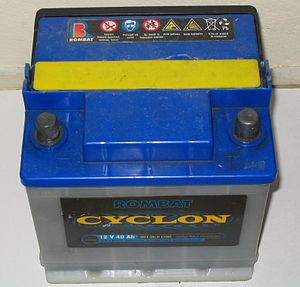
Lead–acid battery

The lead–acid battery was invented in 1859 by French physicist Gaston Planté and is the earliest, yet still most widely used, type of rechargeable battery. Despite having a very low energy-to-weight ratio and a low energy-to-volume ratio, its ability to supply high surge currents means that the cells have a relatively large power-to-weight ratio. These features, along with their low cost, make them attractive for use in motor vehicles to provide the high current required by automobile starter motors. The lead–acid battery was invented in 1859 by French physicist Gaston Planté and is the earliest, yet still most widely used, type of rechargeable battery. Despite having a very low energy-to-weight ratio and a low energy-to-volume ratio, its ability to supply high surge currents means that the cells have a relatively large power-to-weight ratio. These features, along with their low cost, make them attractive for use in motor vehicles to provide the high current required by automobile starter motors. As they are inexpensive compared to newer technologies, lead–acid batteries are widely used even when surge current is not important and other designs could provide higher energy densities. In 1999 lead–acid battery sales accounted for 40–45% of the value from batteries sold worldwide (excluding China and Russia), equivalent to a manufacturing market value of about $15 billion. Large-format lead–acid designs are widely used for storage in backup power supplies in cell phone towers, high-availability settings like hospitals, and stand-alone power systems. For these roles, modified versions of the standard cell may be used to improve storage times and reduce maintenance requirements. Gel-cells and absorbed glass-mat batteries are common in these roles, collectively known as VRLA (valve-regulated lead–acid) batteries. The electrical energy produced by a discharging lead–acid battery can be attributed to the energy released when the strong chemical bonds of water (H2O) molecules are formed from H+ ions of the acid and O2− ions of PbO2. Conversely, during charging the battery acts as a water-splitting device, and in the charged state the chemical energy of the battery is stored in the potential difference between the pure lead at the negative side and the PbO2 on the positive side, plus the Sulphuric Acid in aqueous condition. The French scientist Nicolas Gautherot observed in 1801 that wires that had been used for electrolysis experiments would themselves provide a small amount of 'secondary' current after the main battery had been disconnected. In 1859, Gaston Planté's lead–acid battery was the first battery that could be recharged by passing a reverse current through it. Planté's first model consisted of two lead sheets separated by rubber strips and rolled into a spiral. His batteries were first used to power the lights in train carriages while stopped at a station. In 1881, Camille Alphonse Faure invented an improved version that consisted of a lead grid lattice, into which a lead oxide paste was pressed, forming a plate. This design was easier to mass-produce. An early manufacturer (from 1886) of lead–acid batteries was Henri Tudor. This battery uses a gel electrolyte instead of a liquid allowing the battery to be used in different positions without leaking. Gel electrolyte batteries for any position were first used the 1930s, and in the late 1920s, portable suitcase radio sets allowed the cell vertical or horizontal (but not inverted) due to valve design (see third Edition of Wireless Constructor's Encyclopaedia by Frederick James Camm). In the 1970s, the valve-regulated lead–acid battery (VRLA, or 'sealed') was developed, including modern absorbed glass mat types, allowing operation in any position. In the discharged state both the positive and negative plates become lead(II) sulfate (PbSO4), and the electrolyte loses much of its dissolved sulfuric acid and becomes primarily water.The discharge process is driven by the pronounced reduction in energy when 2 H+(aq) (hydrated protons) of the acid react with O2− ions of PbO2 to form the strong O-H bonds in H2O (ca. −880 kJ per 18 g of water). This highly exergonic process also compensates for the energetically unfavorable formation of Pb2+(aq) ions or lead sulfate (PbSO4(s)).
